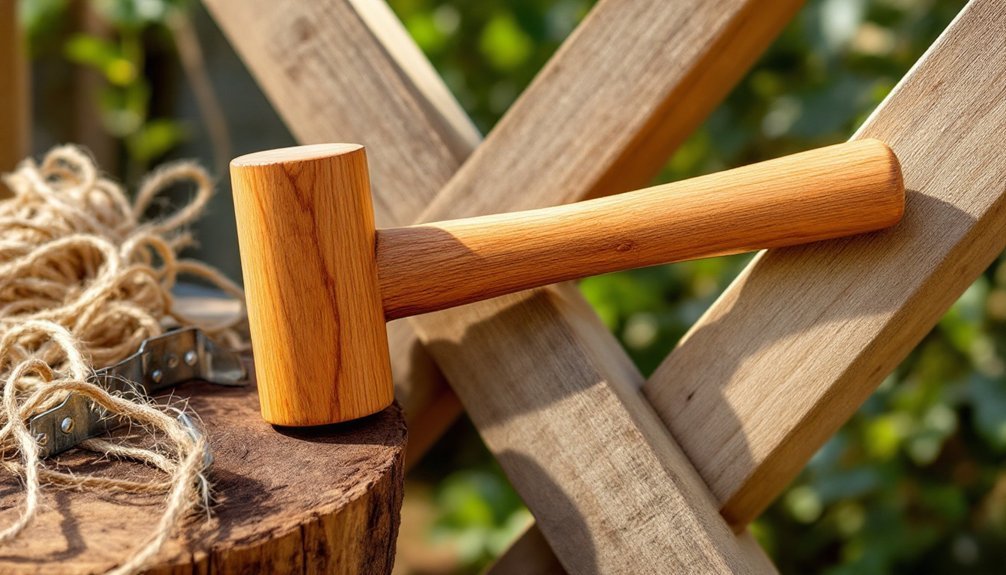When you're assembling a natural fence, the right wooden mallet can make all the difference between struggle and craftsmanship. You'll notice immediately how a quality mallet provides the perfect balance of force and finesse, allowing you to connect posts and rails without damaging their integrity. The weight in your hand, the satisfying thud against wood, and the clean assembly that follows – these sensations await with the proper tool. Let's explore which mallets will transform your fencing project from ordinary to exceptional.
Precision Wood Carving Mallet for Woodworking from Schaaf Tools
Fence builders looking for precision and tool protection will find Schaaf Tools' 15oz Wood Carving Mallet an excellent companion for assembly work. The non-marring urethane head absorbs shock and reduces noise while protecting your valuable tools during repeated strikes.
You'll appreciate the comfortable wooden handle designed to minimize fatigue during extended fence assembly sessions. Its balanced weight offers superior control compared to conventional mallets, making it ideal for precise jointing work.
Though primarily marketed for woodcarving, this versatile tool's increased striking surface area and ergonomic design make it equally valuable for fence construction projects.
Best For: Fence builders and woodworkers who need a precision tool that protects expensive chisels and gouges while providing comfort during extended use.
Pros:
- Non-marring urethane head absorbs shock and reduces noise while protecting valuable tools
- Ergonomic wooden handle minimizes hand fatigue during prolonged use
- Excellent balance and increased striking surface area for precise control
Cons:
- Some aesthetic imperfections in the urethane head
- Primarily marketed for woodcarving, which may not highlight its fence-building applications
- 15oz weight may be too light for some heavy-duty fence construction tasks
Precision Wood Carving Mallet for Woodworking by Schaaf Tools
When building a sturdy fence, the Precision Wood Carving Mallet by Schaaf Tools offers remarkable versatility beyond its intended woodcarving purpose. At 15oz, it's perfectly weighted for tapping fence joints into place without damaging the wood.
You'll appreciate the ergonomic wooden handle that reduces fatigue during long assembly sessions. The non-marring urethane head absorbs shock while delivering precise strikes with minimal noise—ideal when working in residential areas.
Though designed for fine woodworking, fence builders value this mallet for its balance and control. The increased striking surface enhances accuracy when aligning pickets and rails. Despite minor aesthetic imperfections in the urethane, its functionality for fence assembly is undeniable.
Best For: Professional woodworkers and hobbyists seeking a precision mallet for detailed carving, chisel work, and joinery tasks that require controlled force and tool protection.
Pros:
- Ergonomic wooden handle reduces hand fatigue during extended carving sessions
- Non-marring urethane head absorbs shock and protects expensive chisels and gouges
- Excellent balance and weight distribution (15oz) provides superior control for precision work
Cons:
- Some aesthetic imperfections in the urethane head, though functionality isn't affected
- Primarily designed for woodcarving, limiting its versatility for general construction tasks
- Higher price point compared to conventional wooden or rubber mallets
KAKURI Wooden Mallet for Woodworking (Japanese Oak)
Craftsmanship meets functionality in the KAKURI Wooden Mallet, a Japanese-made precision tool that's perfect for woodworkers who need gentle but effective impact. Made from natural oak, this lightweight 6.3 oz mallet won't damage your materials like metal hammers would.
You'll find it ideal for fence assembly, chiseling up to 15mm, and adjusting 42mm planes. At 4.5×1.6×11.8 inches with a 42mm hammerhead, it offers excellent balance for precision work. Some users recommend adding wood glue if the head feels loose, enhancing this already valuable addition to your woodworking arsenal.
Best For: Woodworking enthusiasts and craftspeople who need a lightweight, non-damaging tool for precision tasks like chiseling, adjusting Japanese planes, and assembling wooden furniture.
Pros:
- Made from quality Japanese oak that won't damage materials like metal hammers would
- Lightweight (6.3 oz) and well-balanced for precise control during delicate woodworking tasks
- Versatile enough for various applications including chiseling up to 15mm and adjusting 42mm planes
Cons:
- Some users report issues with loose hammerheads that may require additional wood glue or wedges
- May be too light for working with hardwood or heavier applications
- Non-removable stickers on the handle frustrate some users
GREBSTK Wooden Mallet for Woodworking
The GREBSTK Wooden Mallet stands out as a versatile companion for fence assembly enthusiasts who value precision and comfort. Crafted from high-hardness beech wood with a polished surface, this 12-inch tool delivers balanced strikes without damaging your wooden fence components.
At just 0.81 pounds, you'll find it perfectly weighted for extended use. The 4.5 × 1.9 × 2.4-inch head provides excellent striking power for joining fence posts and rails. While some users mention occasional head loosening, most appreciate its quick delivery and quality construction. For heavier fence work, you might complement this with a rubber mallet, but for precision assembly, it's an excellent investment.
Best For: Woodworking enthusiasts and hobbyists who need a lightweight, precision tool for detailed work with chisels, carved elements, and light assembly tasks.
Pros:
- Made of high-quality beech wood with a polished surface and clear texture for durability and comfort
- Versatile tool suitable for various applications including woodworking, tile installation, and ice crushing
- Well-balanced design at 0.81 pounds with a 12-inch length for precision strikes without excessive fatigue
Cons:
- Head may come loose occasionally during use, requiring maintenance
- Not ideal for heavy-duty projects that would be better served by a rubber mallet
- Limited to lighter woodworking tasks rather than serious construction applications
6Pcs Wooden Hammers, Natural Hardwood Crab Lobster Seafood Mallets
Fence builders seeking versatility will appreciate the 6Pcs Wooden Hammers set from TDOCK. Though marketed for seafood, these solid hardwood mallets excel for lightweight fence assembly tasks where precision matters more than power.
Each mallet measures 7.7 x 2.2 x 1.4 inches and weighs just 10.5 ounces, making them perfect for tapping fence components into place without damaging wood surfaces. The German-style design offers good grip and control.
With six mallets included, you'll have extras for assistants or replacements. Their 4.7-star rating from 241 customers confirms their durability and versatility beyond their intended seafood use.
Best For: Home cooks and seafood enthusiasts who need reliable tools for cracking shellfish like crab and lobster during family gatherings or special dinners.
Pros:
- Set of 6 mallets provides enough tools for the whole family to enjoy seafood simultaneously
- Natural hardwood construction offers durability while being gentle enough not to splinter shells into food
- Versatile design makes them useful for other tasks like tenderizing meat or educational activities
Cons:
- At 10.5 ounces, these may be lighter than metal alternatives for cracking particularly tough shells
- The wooden surface may absorb seafood odors over time if not properly cleaned and maintained
- Limited to lightweight tasks; not suitable for heavy-duty hammering applications
Factors to Consider When Choosing a Wooden Mallet for Natural Fence Assembly
When selecting a wooden mallet for your natural fence assembly project, you'll need to evaluate several critical features. The weight and balance, material durability, and shock absorption quality will determine how effectively you can drive posts and rails without fatigue or damage. The right head size paired with ergonomic handle design guarantees you'll work comfortably through extended fence installation sessions.
Weight and Balance
Finding the right weight and balance in your wooden mallet can make the difference between a smooth fence assembly project and hours of unnecessary strain. When selecting a mallet, aim for one weighing between 15 oz and 1 lb—this sweet spot offers sufficient striking power without compromising control during extended use.
A well-balanced mallet distributes weight evenly between the head and handle, allowing you to deliver consistent, precise strikes with minimal effort. You'll notice this balance immediately when holding the tool; it should feel like a natural extension of your arm rather than a cumbersome instrument.
During natural fence construction, you'll appreciate how a properly weighted and balanced mallet helps you drive stakes and align panels more efficiently, reducing fatigue and improving the overall quality of your work.
Material Durability
A wooden mallet's material quality determines how it'll perform throughout your fence assembly project and beyond. Opt for hardwoods like beech or oak, which offer superior strength and resist wear better than softer woods when driving fence posts and connecting rails.
Look for mallets with polished surfaces to prevent splintering during repeated strikes. Heavier models absorb more shock, reducing stress on both the handle and head during vigorous fence assembly tasks.
Don't overlook maintenance requirements—regular oiling protects against moisture and extends your mallet's lifespan. Before purchasing, examine the construction quality carefully. Tight joints and secure head attachments are essential for preventing failure when you're driving components together. A well-constructed mallet with quality materials will serve you reliably through your entire fencing project.
Shock Absorption Quality
Three critical factors determine a wooden mallet's shock absorption capabilities for fence assembly. First, the head material greatly impacts performance—non-marring heads made from urethane or softwoods offer superior shock absorption compared to traditional options, reducing noise and vibration during repeated strikes.
Second, consider the mallet's weight distribution. A well-balanced tool with proper head-to-handle ratio will absorb impact forces more effectively, protecting both your fence components and your joints from excess strain. Heavier mallets typically provide better shock absorption but require more control effort during prolonged use.
Finally, pay attention to the construction materials. Specially engineered composites or select hardwoods can dramatically improve comfort while maintaining durability. The right shock-absorbing mallet will minimize fatigue, increase strike precision, and protect your valuable fence materials from damage.
Head Size
While shock absorption protects your body, the mallet's head size directly impacts your control and effectiveness during fence assembly. For natural fence construction, look for mallets with heads between 1.5 to 3 inches in diameter, providing sufficient striking surface for driving components into position.
If you're working on intricate joinery or detailed connections in your fence design, opt for a smaller 1.5-inch head that offers precision and maneuverability. For driving stakes or assembling larger fence sections, a mallet with a 2.5 to 3-inch head will deliver more force with less effort.
Remember that head size affects weight distribution and overall comfort. You'll want to avoid oversized mallets that cause fatigue during extended fence-building sessions. The right balance guarantees you maintain accuracy throughout your project.
Handle Ergonomics
Proper handle ergonomics represent the foundation of effective mallet use during fence assembly projects. When evaluating wooden mallets, you'll want to pay close attention to the handle's contour and how it fits in your palm. A well-designed grip considerably reduces hand fatigue during those long hours of driving stakes and joining fence components.
Look for handles crafted from quality wood that provides natural warmth and tactile feedback as you work. The right length and weight balance will improve your leverage and control, especially when precision is needed for striking chisels. You'll also appreciate a contoured design that prevents slippage in various outdoor conditions. Remember, your comfort translates directly to accuracy and efficiency—a properly ergonomic handle makes the difference between struggling through your fence assembly and completing it with ease.
Noise Reduction Features
Beyond comfortable ergonomics lies another important consideration for fence builders: how quiet your mallet operates. If you're working in noise-sensitive environments, choose a wooden mallet with urethane heads, which absorb shock effectively and operate more quietly than traditional rubber or wooden varieties.
Look for mallets specifically designed with noise reduction features. Those with larger striking surfaces allow for more controlled impacts, reducing the overall sound produced during use. A well-balanced mallet improves your handling precision, enabling gentler, more accurate strikes that naturally create less noise.
For ideal noise management, select mallets crafted for tool protection. These typically incorporate sound-dampening materials that not only keep your work quieter but also prevent damage to your fence components during assembly.
Strike Precision
Achieving perfect strikes during fence assembly depends heavily on your mallet's design characteristics. Look for mallets with larger striking surfaces, as they provide better accuracy when delivering force to fence components. A heavier mallet head offers greater momentum, allowing you to make controlled strikes with minimal effort—essential when aligning and securing fence posts and rails.
Consider the ergonomics of the handle; a well-designed grip that fits comfortably in your hand will greatly improve control and precision during repeated strikes. Mallets featuring non-marring materials like urethane are ideal for fence assembly, as they deliver precise force without damaging wooden components. For consistent performance, choose a high-quality wooden mallet that minimizes vibration transfer to your hand, maintaining your accuracy throughout extended fence assembly sessions.
Frequently Asked Questions
How Do I Maintain and Clean My Wooden Mallet?
To maintain your wooden mallet, you'll need to wipe it clean after use, apply linseed oil occasionally to prevent drying, and store it in a dry place. Don't soak it in water or leave it outside.
Can Wooden Mallets Be Used in Wet Weather Conditions?
You can use wooden mallets in wet conditions, but it's not ideal. Moisture can damage the wood, causing swelling, warping, and rot. If necessary, dry your mallet thoroughly afterward and apply oil to protect it.
What Safety Precautions Should I Take When Using Wooden Mallets?
When using wooden mallets, always wear safety glasses, secure your workpiece, use proper grip, check for loose heads, maintain stance balance, avoid overexertion, and don't strike metal objects that could create dangerous splinters.
How Long Does a Typical Wooden Mallet Last?
Your wooden mallet will typically last 5-10 years with proper care. It's lifespan depends on usage frequency, wood quality, and maintenance. You'll extend its life by avoiding overstriking and storing it properly.
Can I Refurbish an Old Wooden Mallet?
Yes, you can definitely refurbish an old wooden mallet. Sand down rough spots, tighten loose heads, apply wood oil or finish, and replace the handle if necessary. It's a rewarding weekend project.





Leave a Reply